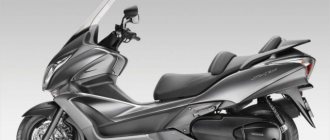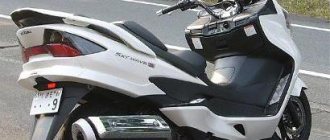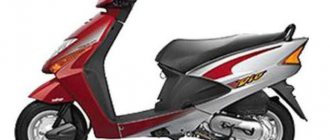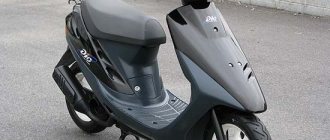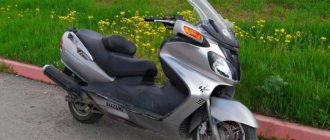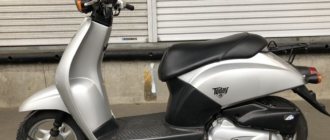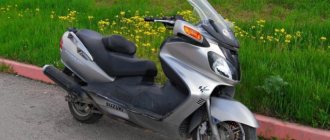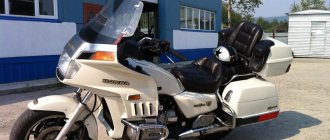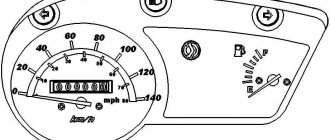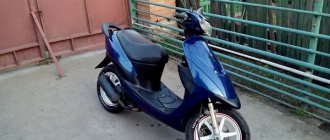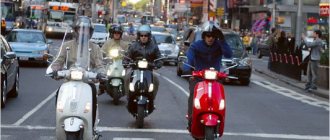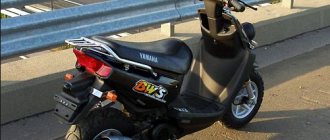Fast civilian or near-sport motorcycles are not always convenient in everyday life. As practice shows, relatively low-speed maxi-scooters in the city and on the highway are many times superior to the vast majority of motorcycles in terms of comfort and traffic intensity. Today we’ll look at the trendsetters of the genre - as a vehicle with mileage and history, let’s take the Honda FJS 600 Silver Wing of the 2001-2008 model, and as a current analogue - the most modern existing Suzuki AN 650 Burgman.
Honda FJS 600 Silver Wing (2001–2008, RUB 120,000–300,000)
The first generation Silver Wing in the 600 cc version is one of the most popular and in demand maxi-scooters. The model has long been discontinued, but the popularity of the Japanese “sofa” with a memorable diamond-shaped headlight has only grown over the years.
Engine
The 582cc eight-valve parallel twin with electronically controlled fuel injection and liquid cooling is fantastically reliable. It does not consume oil even in the most advanced cases. No sores or weak points were noticed. With adequate maintenance, the engine can easily last 100,000–150,000 km without major repairs.
Transmission
The CVT transmission is designed as is, with absolutely no bells and whistles. Which has a positive effect on resource and reliability. The mechanism is similar to that of a fifty-kopeck scooter. Weights, pulleys and belt. Nothing more! The result is a non-violent character (for fans of dynamics, it makes sense to sharpen their skis in the direction of expensive tuning), which is more than compensated by reliability that borders on the fantastic.
Frame and body kit
At the current time, the frame design can already be called obsolete. The spatial steel part does not have sufficient rigidity, which does not have the best effect on handling.
Silver's plastic is dense and thick. The abundance of mounting eyes is not the best for long-term use. Fasteners often suffer during repairs; plastic parts begin to rattle and join with an uneven gap.
Brakes
The braking system is Silver's strong point. Despite the absence of a second brake disc on the front wheel. All 600 cars are equipped with a combined brake force distribution system. When you press the front brake lever, the two pistons of the front caliper are activated. Pressing the rear brake lever activates one front caliper piston and two rear caliper pistons.
Pendants
The chassis of the Honda FJS 600 Silver Wing, so to speak, is designed strictly according to scooter canons. Without introducing solutions from the world of cubic motorcycles. The fork is short and flimsy, without additional yokes. Hence the lack of rigidity, which, together with a not very monumental frame and a simple rear suspension with two shock absorbers, reduces the “driver’s” to a minimum. The suspension is generally strong and reliable, but unlike many competitors, it is not conducive to active, almost sporty driving. It is worth paying attention to the mounting ears of the rear shock absorbers and the engine-frame “rocker”. Driving on roads of poor quality may cause serious gaps and cracks in these places.
Comfort
The standard windshield on the Honda FJS 600 Silver Wing is large, but not adjustable. Tall drivers will have to order aftermarket windshields or additional add-on sections. The suspension, despite its incapacity for hyperactive steering on uneven surfaces, behaves extremely adequately. The scooter passes through potholes, joints and other misunderstandings smoothly and softly. Tall drivers may feel uncomfortable driving the Silver. An individual with a height of over 190 cm is guaranteed to rest his knees on the front panel.
Modifications
Silver Wing debuted in 2000. There are two cubic capacity options at once - 400 cm3 and 600 cm3. In 2002, the relay regulator was moved under the fairing. In 2003, a “Mode” button appeared, allowing you to slightly “cheer up” the injection maps, and ABS also appeared as an option. In 2004, a slight restyling took place - the shape and fastening of the glove compartment lids changed, the headlight reflector housing became chrome-plated, the material of the seat upholstery changed, the instrument panel lighting became brighter, the lower fork cups and rims began to be painted black. In 2006, an immobilizer and side lamps in the headlight appeared, and the display backlight on the dashboard became blue. In 2008, Honda polished up the Silver for the last time before the generation change. Distinctive features are gold-colored wheels, calipers and nameplates, as well as carbon-fibre seat trim. In 2009, the design was radically updated, and changes were made to the engine.
Technical parameters of the model
The qualitative characteristics of the Honda Silver Wing 600 should be given, identifying its strengths:
| Dimensions (length; width; height) | 227.5; 77; 143 cm |
| Weight | 247 kg |
| Maximum speed | About 162 km/h |
| Tank volume (fuel; oil) | 18.4 l; 2.6 l |
| Load capacity | 180 kg |
| Engine | 4-stroke 2-cylinder liquid cooled |
| Fuel consumption | 5.5–8 l |
| Engine capacity | 582 cc cm |
| Start | Electric starter |
| Piston parameters (stroke; diameter) | 7.15; 7.2 cm |
| Engine power | 50 l. With. at 7000 rpm |
| Brake system | Disk |
| Suspensions (front; rear) | Telescopic fork; 2 shock absorbers |
The Honda Silver Wing 600 looks more impressive in the video than in any photograph, so to fully familiarize yourself with the model, it’s worth studying several video reviews.
Suzuki AN 650 Burgman (2013 – present, RUB 400,000–650,000)
It's hard not to notice Suzuki's passion for producing maxi-scooters. Specifically, “Burgmans” are present in all running cubic capacity ranges of 125–650 cm3. “650” is the flagship of the model range and at the same time one of the most comfortable maxi-scooters on the planet.
Engine
The strongly forward-inclined two-cylinder injection four-stroke liquid-cooled engine does not shake much with charisma, but it drives assertively and efficiently. In the world of maxi-scooters, it stands out for its impressive low-end thrust and top speed of around a record 200 km/h. This power unit produces little vibration; it begins to eat oil only in the most advanced cases. Mileages of 100,000 km or more with proper maintenance are not uncommon.
Transmission
The transmission of the Suzuki AN 650 Burgman is made according to a complex, rarely used design. The engineers who created it are great fellows, but there are, nevertheless, reasons for criticism. The classic V-belt variator in the case of the large “Burg” is equipped with an add-on in the form of electronic control via a servo drive. The electronic brain gives the scooter a quick response to turning the gas handle and efficiency. It is possible to switch to manual mode with five virtual gears, as well as switch to Power mode (analogous to sport mode). The weak point of the variator and, at the same time, the main problem of all AN 650 Burgman lies in the gear ratio control mechanism. The servo has two small all-plastic gears that interact with each other and with larger metal gears. Plastic tends to wear out and deform from high temperatures. As a result, the scooter may become immobilized at the most inopportune moment. No one can guarantee you how much longer the scooter will travel, 1000 km or 10,000 km. Repairing this sore in the field is not possible. Ideally, it makes sense to replace plastic gears with metal ones from third-party masters.
Frame and body kit
The complex steel frame and ornate steel rear subframe provide a robust design that requires no additional reinforcement. Thick plastic reliably protects the “internal organs” of the scooter in case of falls. Plastic parts in the most vulnerable areas are equipped with wear-resistant pads.
Brakes
The brakes of the Suzuki AN 650 Burgman could be the benchmark among maxi-scooters, if not for the weakness of the front and rear brake levers. This problem is solved by installing reinforced brake hoses.
Suspension
Despite the external gloss and advanced equipment, the Burgman is primitive in terms of suspension. There are no special complaints about the telescopic fork, which cannot be said about a pair of shock absorbers in the rear suspension. For such a bulky and cubic “sofa” the shock absorbers are nearly enough. Especially regarding torsional rigidity. When driving diagonally along serious irregularities, the scooter’s stern continually dances a very unpleasant dance, which can turn into a dangerous departure from the intended trajectory.
Comfort
Due to its considerable dimensions and thoughtful ergonomics, the Suzuki AN 650 Burgman comes close to luxury tourer motorcycles in terms of comfort. When driving in dense city traffic, the Burg may be too wide, but the engineers came up with a way out here too. Due to the servo-driven folding rear view mirrors, the dimensions of the scooter can be changed on the fly. Driving along the highway is a pleasure. Including due to the presence of an electric windshield.
Modifications
The current generation Suzuki Burgman 650 (production since 2013) is supplied to the market in two versions: standard and Executive. The second one is distinguished by heated handles and a backrest for the passenger. Both versions are equipped with an ABS system, which was previously installed only on the Executive version, and an Eco indicator on the dashboard.
Hi all! I am writing about my experience of owning a 2004 Honda Silver Wing 400 maxi-scooter. I described the purchase process, registration and first impressions in the previous post. At the moment, the odometer shows 44,000 km, that is, I have driven 14,000 km and continue to drive, despite the not the best weather in Moscow. I drive almost every day and have never regretted it, rain, night, cold, nothing stops me from getting behind the wheel, and the vehicle itself contributes to this.
I took the device as a practical means of transportation for every day and to fulfill an old dream - traveling on two wheels to the Crimea, so as not to spend half the price on preparing the motorcycle (wind deflector, mounts, panniers, the maxiscooter has all this in the base) and the choice was completely justified. In light rain you can do without a raincoat, the wind protection is good, your feet are always dry. For the second number, the situation is a little worse, the legs are on retractable footrests and all the wind and water hits them, as well as the hands and helmet, since the passenger sits slightly higher than the driver. Some people solve this by installing side deflectors and a Givi Airflow windshield, but I stayed with stock.
The most practical city vehicle, I would call it a two-wheeled car, the comfort and luggage capacity are pleasing. I bought an additional Chinese case for 51 liters. for 5000 rubles, nothing fell off, nothing became loose, although I loaded it heavily. I shop at Auchan for two for two weeks and everything fits. It’s convenient that you don’t have to carry around with a helmet; when you arrive, you put it in the trunk and go.
Driving around the city is a pleasure, CVT, no work with the clutch or gears, the device is quite narrow and fits in the same places as all other two-wheelers. 250 kg of weight on Dunlop Scootline tires hold the road perfectly, the rear skidded twice in a turn in a wet place, I just eased off the gas and leveled off, the combi brake on the left handle is again very convenient, if it’s not enough I apply the brakes with the front handle, it never blocked, and I stopped where I wanted. Some say the brakes are sluggish, for such a mass and two brake discs this may be true, but it’s always enough for me, again, everything is individual. During the season I changed all consumables and fluids. At first I drove with synthetic car oil, the engine is similar to a car without a wet clutch, then I switched to Motul Scooter Expert because I found an affordable supplier, I didn’t notice any difference. At first the engine was burning oil - I decarbonized everything and everything was back to normal. The manual says to change the oil every 12,000 km, I changed it at the beginning of the season, then at 8,000 km. Oil filter 500 rubles. Nissin pads, 2500 rub. front and the same amount back. Luka antifreeze, no complaints, the temperature was always normal even in the hot Crimean climate. I changed the brake discs since the original ones were already noticeably worn out, I ordered the simplest ones from eBay, the front and rear ones cost 5,000 rubles. I didn’t notice any difference with the original, and after replacing the brakes and pads everything became even better.
I got the device with a variator and a Malossi belt, the dynamics in the city, given the two-boiler 38 horsepower engine and despite the weight of 250 km, are very decent, as for me, without failures, it reaches 5500 rpm and accelerates at the moment to 90 km/h, then the power and maximum work reaches a maximum speed of 150 km/h at the cutoff (tried it once), and the cruiser on the highway is 110-120 km/h at 6500-7000 rpm. I planned to install a stock valve and belt (5000+5000 rubles) to slow down the speed, since I’m not much of a racer, but then I got used to it and was afraid of losing dynamics, and I don’t go out on the track very often. With a passenger, the dynamics drop slightly, but this did not stop me from driving to the Crimea and back in two on a scooter loaded to capacity, I did not feel any inconvenience. Consumption due to the CVT does not change much depending on the city and highway and is 5-6 liters per hundred. With a tank of 15 liters, after the 200 km mark on the odometer, I look for a gas station; I don’t particularly rely on the fuel level sensor, since the first two bars are enough for a hundred kilometers, and the remaining 4 bars go away faster. The manual says to pour gasoline above 91, I fill it with 92, tried 95 - I didn’t feel any difference.
About the suspension. I expected much worse, since the wheels are small (14 front, 13 rear), but everything turned out to be not so bad, in the city there is nothing to complain about at all, speed bumps are driven over just like in a car, leisurely. The ground clearance is almost the highest among the Maxi cars, I paid attention to this when choosing. It probably hit the suspension only 3 times, and then on the rough roads of Crimea with two people on a loaded scooter. Some people say that the front suspension is rather weak and soft, fill in thicker oil 15-20w, install valve springs from VAZ, but I am completely satisfied with the oil according to the manual 10w, everyone has their own driving style. The rear suspension is adjustable, for me it is 4 out of 5 in terms of stiffness.
Now a little about the Crimean journey. I took a vacation for two weeks, we planned to leave on August 15, it was another day, 13 degrees and rain, but that didn’t stop my friend and I, we loaded our things, dressed warmly, put on our raincoats and off we went. Despite the conditions on the wet track, I was moving consistently at about 100 km/h, there was no need to be nervous, Silver walked like a cruiser along its fairway, and after the rains it reached the usual 110-120 km/h. We prudently bought Intex air cushions, attached them with double-sided tape, and the backside was the last thing that got tired during the trip, the main thing was to pump up the right amount of air. I won’t go into much detail, enough has been written about the road to Crimea at Bikepost and my journey in this regard went without any surprises, with the exception of the dead bearing in the front wheel already at the entrance to the planned housing in the city of Sudak. Driving in the dark along a serpentine road with a threateningly crunchy bearing, let me tell you, is not for the faint of heart. By the way, the light on the Silver is rather weak, you can only see the markings, and the shadows from the bumps on the road in front of your nose, the adjustment did not help. In the end, I successfully arrived, bought bearings in Simferopol and replaced them. On the way back to Voronezh I caught a nail in the rear wheel. He pulled it out and put on a tourniquet. 100 km from home I discovered a flat tire, drove another 20 km constantly pumping it up, and finally decided not to risk it and called a tow truck. Then I changed the tires to the same Dunlop ones, I’m completely satisfied. Nothing else broke during the entire season. The impressions from the first long-distance trip were mixed, I seemed to like it, but as a vacation it was not the best option, since out of a two-week vacation, 6 days were on the road (3 days there, 3 days back, 600 km a day) and 7 days resting in Sudak . A few photos: I’ll say something about the 600 cc version, initially the scooter was designed specifically for this engine, and the 400 cc version was made later. I knew very well about the advantages of a larger capacity vehicle: it has better dynamics and higher cruising and maximum speed, while it is expectedly more expensive and consumes more fuel. To be honest, on the highway I would gladly drive a 600, but in the city the difference is not so visible, and lower fuel consumption is a plus for a 400. My version competes with the 400 Skyway, and the 600 already competes with the 650 Burgman, both in terms of characteristics and cost, and the choice is not so obvious.
As for the maxiscooter class itself, my opinion is the following: yes, this is not a motorcycle. You won't get the same emotions as in sports from acceleration and speed. You won't get the same emotions as a cruiser, slowly driving around the city with the exhaust rumbling. There is nothing to say about off-road. This is just a workhorse, as practical and reliable as possible. I’m completely happy with this season and the fact that I rode it on Silver, but next season I’ll probably take a motorcycle. Now I’m slowly selling it, it’s in the advertisements, if I don’t make it before the snows, I’ll put it in storage.
Separately, I would like to say about the Northern Wing Silver Breeders Club, of which I had the honor of becoming a member, they are very kind, cheerful and sympathetic people who are ready to help or give advice at any time, it’s a pity that it’s not possible to go to meetings so often.
Thank you for your attention!
Controllability
Have you ever wondered what class of “ordinary” motorcycles can be classified as maxi scooters? We decided that these would be sports tourists , because good wind protection, good power supply, hooding, standard luggage capacity and a dislike for off-roading are inherent in this class. And the design of our four devices is very similar to the “faces” of such motorcycles. And since we're testing quasi-sport tourers today, we decided to test their handling on winding roads leading to nowhere, with everything you need on board. We were quite impressed with all four, but one in particular stood out.
Making your way through the city or along a bypass, they all feel about the same. All have rear suspension preload adjustment, and we appreciated the Honda's softness for normal driving. “Good around town and on flat roads,” according to one of us. At first, the Burgman felt a bit harsh on the highway, but that feeling faded over time.
BMW C650GT
But the BMW C650GT impressed with its composure. “BMW seems to have found the fine line between precise handling and outright stiffness of the suspension,” noted a colleague. Ride quality teetered on the edge of comfort for normal driving, but with all four of us comparing the experience on twisty roads, the firm suspension is an acceptable price to pay for the almost sporty handling precision.
Kymco MyRoad 700i surprised us. Despite the electronic suspension adjustment, it was disappointing to say the least.
I was hoping to play with the electronic suspension and find my balance, but in fact I was only upset,” said one of my colleagues. -It turned out to be extremely hard in the softest position, so there was no need to try a harder setting.
Things got a little better when we loosened the spring preload on the rear suspension, but the fork was still stiff.
I think the culprit here is that the high-speed compression smoothing is too long,” continues the colleague. -The MyRoad electronic suspension could be a huge benefit if it worked as it should. She definitely wouldn't make a Gold Wing out of a sportbike, but she could make the Kymco more comfortable.
Of course, going all the way to the footrests is not what most people buy maxi scooters for, but we didn’t buy them, we took them for a test. Considering that we also tested the C600Sport right after its release, we immediately agreed to test their extreme lean angles, so we headed to the nearest serpentine road to test their sporting capabilities. And what we found is surprising not only to you, but also to us: all four turned out to be more athletic than you expect from them.
Honda Silver Wing
They are not sportbikes by any means, but:
Each offers immediate steering response, although their long wheelbase increases the turning radius, says our tester. -This is especially noticeable with Honda. The front turns, and then, after a short but noticeable pause, the rear follows.
Disadvantages of a maxi scooter
In addition to the advantages, the model also has minor disadvantages:
- The combination of large mass and small wheel radius limits the off-road capability of a maxi-scooter.
- The technical characteristics and parameters of the car make overtaking maneuvers difficult. The maxi-scooter is also heavy when accelerating. But it’s worth considering that it was created for city traffic.
